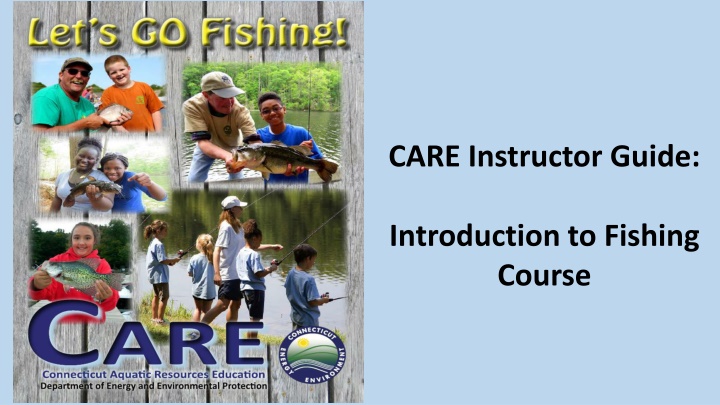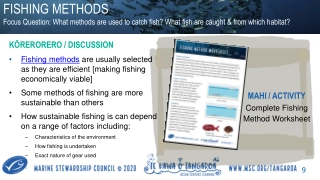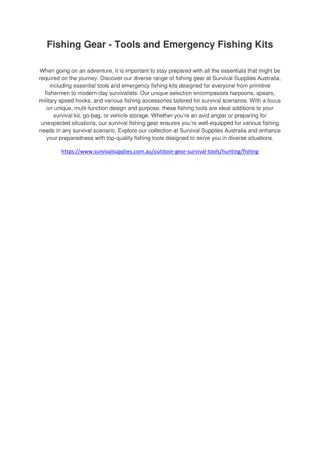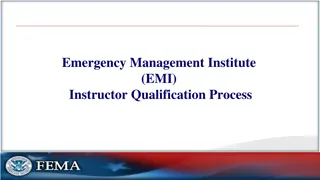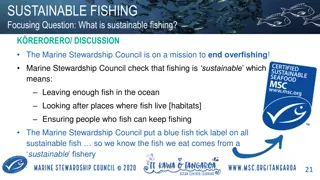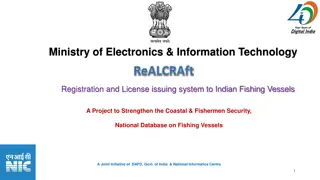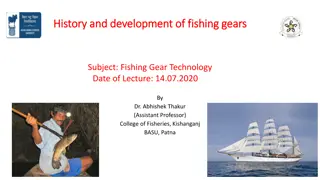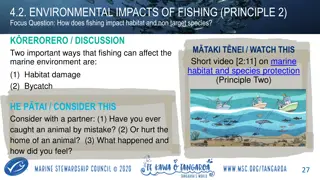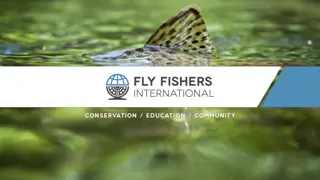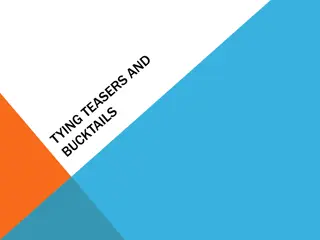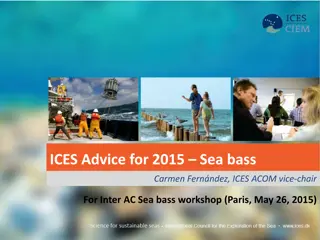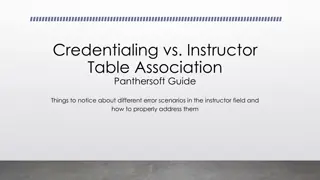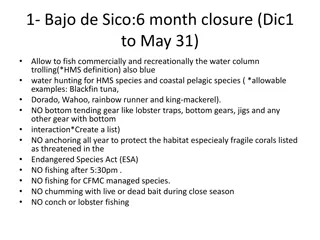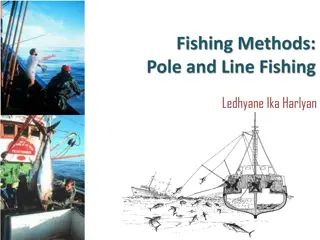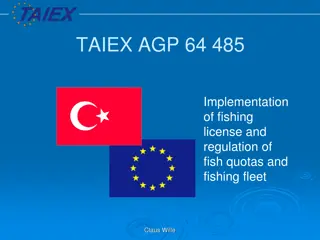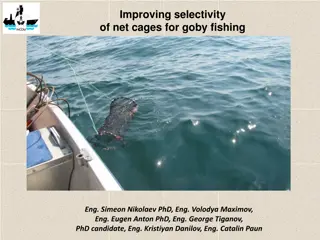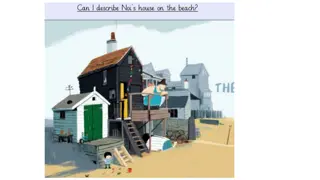Introduction to Fishing Course: CARE Instructor Guide
Welcome to the CARE Instructor Guide for the Introduction to Fishing Course. This course covers topics such as rod and reel setup, tackle, knots, rules and regulations, fish identification, ecology, baits, care of catch, and casting. Learn about the CARE program, funded through Sport Fish Restoration Act and U.S. Fish and Wildlife Service. Discover the basics of fishing tackle setup and knot tying. Join us in exploring the world of freshwater fishing!
Download Presentation

Please find below an Image/Link to download the presentation.
The content on the website is provided AS IS for your information and personal use only. It may not be sold, licensed, or shared on other websites without obtaining consent from the author.If you encounter any issues during the download, it is possible that the publisher has removed the file from their server.
You are allowed to download the files provided on this website for personal or commercial use, subject to the condition that they are used lawfully. All files are the property of their respective owners.
The content on the website is provided AS IS for your information and personal use only. It may not be sold, licensed, or shared on other websites without obtaining consent from the author.
E N D
Presentation Transcript
CARE Instructor Guide: Introduction to Fishing Course
WELCOME & INTRODUCTION (Slide 2 Page ii) Distribute registration cards and distribute Let s Go Fishing! student manual Information used for survey purposes only Email will allow us to get fishing related information and news to students to help increase success! Distribute SURVEY CARD with survey monkey link to gather students post-class feedback. Introduce Instructors and CARE Program This course is designed as a basic introduction to the family sport of freshwater fishing. Topics to be covered will be rod and reel setup, tackle, knots, rules and regulations, fish identification and ecology, baits, care of the catch, and casting. Connecticut Aquatic Resources Education (CARE) program has taught over 180,000 people since 1986 and utilizes Volunteer Instructors - Over 700 Instructors trained and certified. Connecticut Dept. of Energy and Environmental Protection Fisheries Division CARE is part of Fisheries Division (IFD). Goal of IFD is to: Conserve and enhance fish populations, Enhance recreational fishing opportunities. 100% of sportsmen license fees go directly to support improving fish and wildlife in CT!
WELCOME & INTRODUCTION (Slide 3 Page iii) CARE FUNDING No tax dollars used to support CARE program! 1. Sport Fish Restoration Act (SFRA) collects excise taxes from fishing and boating related sales from manufacturers. 2. U.S. Fish and Wildlife Service manages monies and gives back to state agencies to improve fish, wildlife, and boating. 3. CARE runs on 75% SFRA dollars and CT is responsible for 25% in-kind match, which instructor volunteer time has accounted for since 1986! 100% back to fisheries programs (by state law) Your License Purchase Deposited into CT General Fund CT Fishing License Funding Federal Sport Fish Funding
FISHING TACKLE 1 Demonstrate Rod and Reel set-up Demonstrate with CARE spincast rods. Optional bring your own spinning rod, fly rod, baitcasting rod to show. Assemble two piece rod Line up guides and push ferrules firmly together. Pull line up through guides be sure line is not wrapped around rod. Terminal tackle Explain and demonstrate how to attach bobber and proper placement for different fishing situations. Explain and demonstrate how to attach a removable spilt-shot sinker. Discuss placement of sinker on line. Parts of the hook eye, point, and barb. Pinch barbs to create a barbless hook. Chapter
2 Chapter KNOTS Attaching the Hook Demonstrate tying the Improved ClinchKnot using wooden hook and rope. Repeat knot tying process using a volunteer from audience. Hand out monofilament line and paperclips and have students tie improved clinch knot. Assist as needed. Have students teach other students. Explain that pound-test means that the manufacturer guarantees the line will not break below pound-test stated on spool (i.e. 6 lb test will take 6 lbs of pressure to break). Higher the pound-test, the thicker the line but stronger (for pike and bass). Lower the pound-test, thinner the line but weaker (trout and panfish) CARE uses 6 pound-test which is perfect for freshwater fishing in CT. Mention www.animatedknots.com is an excellent online interactive resource to learn to tie knots.
RESPONSIBLE AND ETHICAL ANGLERS (Angler s Guide) 3 Chapter Distribute the Angler s Guide (bookmark and flag key topics prior to class) Angler s Guides - updated yearly because regulations and information change. DEEP phone numbers and website address. Report Violations at 1-800-842-4357. CARE program webpage and upcoming events. Fishing license requirements 16 years old require fishing license *emphasize 100% of license fees go to support improving fish and wildlife in CT*. Aquatic invasive species Help Stop the Spread! Statewide species regulations: Explain open and closed seasons, minimum length, and daily creel limit. Identify regulations for panfish, trout and bass. Have students follow in guide answering methods, seasons, etc. Lakes and Ponds regulations: Select a local pond or lake and guide students to use lake and pond legend and key to fish species abbreviations. Explain that some lakes and ponds may have specific regulations that supersede general statewide regulations. Demonstrate an example.
3 Chapter RESPONSIBLE AND ETHICAL ANGLERS Discuss Outdoor ethics and Sportsmanship means following rules, respecting others, and leaving your fishing area in better condition than you found it. Example: pick up trash (even if its not yours!). Anglers should show non-fishing public that we respect and take ownership of our environment. Ethical anglers do the right thing even when nobody is watching! Discuss Proper Catch and Release Have camera and pliers ready Support large fish by tail and belly and hold horizontally (see picture) . Keep fish in water and handle as little as possible. Wet your hands before handling fish to protect slime coat on fish. If fish swallows hook, cut the line as close as possible to hook.
4 Chapter GOING FISHING Fishing Trip Preparation Call a friend or relative and invite them along. Share the experience! Watch Weather proper clothing to match weather conditions. Check regulations in Angler s Guide for the body of water you plan to fish. Check your gear condition of line, organize tackle box, and make sure you have bait. Notify someone about where you are going and when you expect to return. Where are the fish? Refer to diagrams on Chapter 4 Page 8. Look for structure rock piles & boulders, sunken logs, docks, and weed edges all attract fish. Changes in depth fish like drop-offs in depth and channels. Lake and pond contour maps You can find most CT lake maps at www.ct.gov/DEEP/fishing or you can purchase a book called A Fisheries Guide to Lakes and Ponds of Connecticut . Trout Stocking Location Maps on DEEP web site. Check Facebook and Twitter for Daily Stocking Updates.
5 Chapter FISH IDENTIFICATION Identification of Connecticut Fish Use FISH FLASHCARDS and SLIDES 8-23 to show students different species. Back of flashcards have useful information to help describe fish. CARE staff will bring fish taxidermy display (class must have minimum of 15 students). TALKING POINTS: Different shapes of fish and the habitat the fish would occupy. Different color patterns that allow some protection by camouflaging in with habitat. Different locations of fins which allow fish to maneuver in different ways. Explain which fish are predators and which are prey. Predator fish Panfish Largemouth Bass Bluegill sunfish Smallmouth Bass Calico Bass Trout species Yellow Perch Northern Pike White Perch Chain Pickerel Pumpkinseed Sunfish Walleye Catfish
BAITS AND LURES 6 Discuss Natural Baits Emphasize that natural baits are ideal for beginners Live baits commonly used for fishing like worms, meal worms, and minnows Explain how to put each bait on a hook Explain how to find your own worms by digging in soil, leaf piles, and compost piles Explain how to go on a night crawler hunt Where is the closest bait shop to purchase live baits Chapter Artificial lures mimic natural baits Refer to pages 13 and 14 Once students gain experience, there is an endless variety of artificial lures
CARE OF THE CATCH 7 Chapter Harvesting of Fish for the Table Fish is part of a healthy diet! High in omega-3 fatty acids and protein, and low in fat and cholesterol. Therefore, fish is a good choice of food so long as you follow the guidelines published by the State Department of Health Keep harvested fish cold and on ice to preserve freshness. SELECTIVE HARVEST - It is better to keep panfish and smaller gamefish and release large trophy size fish. This will help to preserve future fish populations and limit consumption of bio- accumulates. Refer to manual for directions and fish filleting and cooking. a. High Risk Group includes pregnant women, women planning pregnenacy within a year, nursing women, and children under age 6. The High Risk Group should eat no more then one fish meal per month of most freshwater fish from local waters. b. The Low Risk Group should limit eating most freshwater fish to once a week. c. Most trout are not part of the advisory and are safe to eat. However, the high risk group should eat no more than one meal of large trout (>15 ) per month and should not eat trout from the Housatonic River. Play Care of the Catch video segments *PLEASE SEE ANGLERS GUIDE FOR SPECIAL ADVISORIES FOR SPECIFIC SPECIES ON SPECIFIC WATERBODIES*
CASTING 8 Chapter Learning to Cast a Spincast Rod & Reel Set up Backyard Bass in an area of short grass or asphalt. Gymnasiums will work as last resort. Avoid over-hanging branches, overhead wires, or any other potential tangling objects. Set up 5 or 6 rods with casting plugs. Avoid having too many students casting at once. If there is no area to cast, perform casting practice first thing on day of fishing trip. Explain Steps to Casting Hold rod with reel facing upward. Push and hold button on back of reel. Look around to avoid humans and/or objects that would cause a snag. If safe, slowly bring rod over your shoulder. To cast, swing rod forward releasing button right after rod tip passes the vertical position.
Additional Information and Resources (Slide 33- 34) SLIDE 12 Refer students to additional chapters in manual to learn more about fishing CT: Chapter 9 Fisheries Management Ice Fishing Saltwater Fishing Chapter Encourage students to test their new knowledge with ACTIVITY GUIDE questions pages 24-27 facebook logo Search: CONNECTICUT FISH AND WILDLIFE and on Twitter @CTFISHINGINFO Students can stay connected via Facebook and Twitter SLIDE 13 DEEP has printed media available: CT wildlife magazine FreshwaterFishes of Connecticut book Fisheries Guide to Lake and Ponds of Connecticut DEEP website offers www.ct.gov/deep/fishing : trout stocking interactive maps lake and pond contour maps Weekly Fishing Reports Electronic CT Fishin Tips newsletter CT is Fishy interactive application
Fishing Trip (Slide 35) Fishing Trip INSTRUCTORS SHOULD PICK SITE OF TRIP AHEAD OF TIME Scout area for hazards. Avoid rocks, steep banks, streams and rivers. Look for an open shoreline void of overhanging trees, brush, and thick aquatic vegetation Consider creature comforts picnic tables, restrooms or outhouse (Trout Parks and Community Fishing Waters!) Discuss with students: What waterbody are you fishing and where you will meet? What time? Have students bring their own bait! Recommend a local Bait and Tackle shop or they can dig their own worms. Rain or shine? Decide and discuss a rain date if possible. Reminder parents to bring: Snacks, lunch, water. Sunscreen, sunglasses, wipes or towels, bug spray, extra footwear or clothes. Cooler with ice if they plan to harvest fish. Rods and reels if they wish. Or they could borrow CARE equipment. Students should set up their own rods and reels with guidance from Instructors. Instructors consider setting up a few rods and reels with casting plugs to practice casting with backyard bass.
SUMMARY & CLOSING (Slide 35) Here is your opportunity to inspire your class to go fishing! Emphasize: - Fishing is a great family activity - Have Fun! - CT has diverse fishing opportunities: Lakes, ponds, rivers, streams, and Long Island Sound - 100% of sportsmen license fees go directly to support improving fish and wildlife in CT! - Enjoy the beautiful surroundings and wildlife while fishing Thank your students for coming to the class and get pumped up for our Fishing Trip! Hand out survey card and remind class to take the survey!
